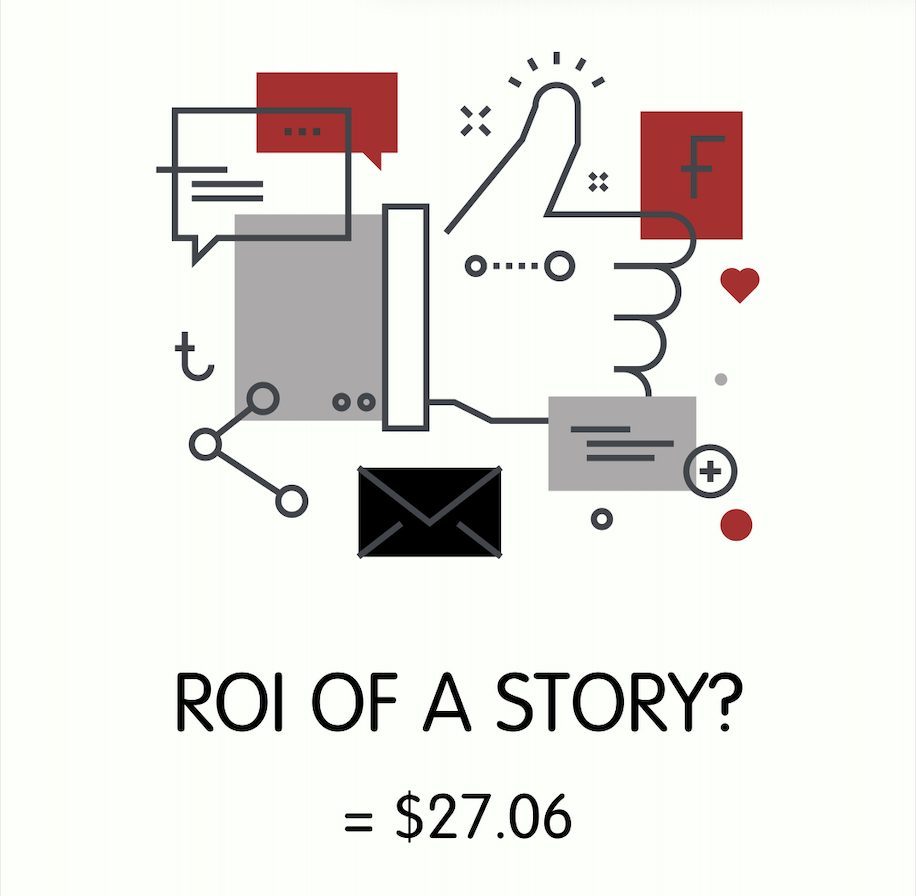I was born into a family of readers. Long before I knew what that would mean for my life, my well-being and my career, I had been gifted both a healthy addiction and key tips to creating effective content marketing that would drive what I would do with my life.

In fiction, I revel in great writing and great writers and my taste is eclectic, crossing centuries, countries, styles. At the top of my favorites, and who have had profound impact on my life and thinking, sit Chekhov, Dickens, Nabokov, Munro, García Márquez, Austen, Tolstoy, James, Tyler, Bellow, Roth, on and on.
I’ve hauled their books around with me over more decades than I want to admit here, in dozens of boxes, across continents and countries, in vans, cars, trains, boats, planes and briefcases.
What do they all have in common, the gift that keeps on giving?
They tell great stories.
They tell us about those around us, as well as ourselves, and the world we live in.
And they show us the way to creating great content ourselves. How they do it is both subtle and obvious, and always delightful (even when the subject matter is painful).
The lives they lead
From David Copperfield to Elizabeth Bennett to Colonel Aureliano Buendía to Augie March to Humbert Humbert to Anna Karenina, their characters illustrate aspects of our existence and make us think about what we do, how we do what we do…and why.
That’s why when I enter someone’s home for the first time, I try to make a beeline for their bookshelves. That way, I have an immediate sense of who I’m dealing with, how they think and what they care about. It’s one way to anticipate what to expect from our time together.
It’s an insight into my audience of the moment.
It’s amazing how what goes around, comes around. I had no idea when I founded a content company that the lessons of literature and great writing would underpin our approach as content creators and content marketers.
Whether we’re reading for personal or professional reasons, we return to the sources we trust, the authors we believe, the analysts we consistently value because the content they create is meaningful to us.
And that’s what we should represent to our own audiences. They should value our content for the same reasons we value those we trust.
As content creators, we have much to learn from the wisdom and brilliance of great writers. There are the obvious ways:
- Effectively structuring complex material (payoff: logical flow of content, easy to follow)
- Unlocking the power of the telling detail (payoff: a critical example is worth paragraphs of description)
- Ensuring economy of language (payoff: wasted words waste time)
- Displaying empathy and understanding of the audience (payoff: enriching your buying personas)
- Showing, not telling (payoff: creating visual images with language improves recall)
- Surprising and delighting, informing and educating (payoff: increases engagement and loyalty)
Life’s Pleasure
As a young journalist, I learned that what matters most is the single sentence – a few, if you’re really good – that a reader will remember from your story later.
For me, that means opening sentences like this, from Vladimir Nabokov’s wonderful autobiography, Speak, Memory: “The cradle rocks above an abyss and common sense tells us that our existence is but a brief crack of light between two eternities of darkness.”
Or this, from Jane Austen’s Emma: ” “Emma Woodhouse, handsome, clever, and rich, with a comfortable home and happy disposition, seemed to unite some of the best blessings of existence, and had lived nearly twenty-one years in the world with very little to distress or vex her.”
Such sentences are packed with meaning, every word carefully weighed, building to a conclusion that foreshadow everything that’s coming — and keeps the readers (think: your audience) moving to where the author (think: content marketer) wants them to go.
It’s the kind of writing that opens a window — a door, really — to walk through and escape this world while learning about it at the same time, guiding the audience into seeing things differently, imagining possibility where they might not have otherwise.
Content Marketing Tip 101: Walk The Walk
To one degree or another, isn’t that what we all want for the content we create? A well-crafted, well-told, engaging story that will seduce our audience — regardless of the medium.
If the audience believes in your story, blog, infographic, podcast or video, they’ll believe in you, your brand, your product, your service. “Hook” them with content that’s irresistible, that invests them in you, and you’ll see better results — for example, social likes and shares, longer and more sustained engagement with your material.
Then they’re on the way on the buyer’s journey to your golden land, leads that evolve from unqualified to qualified and, finally, to conversion.
As a foreign correspondent some years ago, I had the great privilege to spend time with Gabriel García Márquez for a story I was writing. It was late in his life and he knew time was running out.
How did he spend it?
“I don’t read new fiction any more,” he said. “I reread the books I love.”
As content marketers, that’s what we want for our audiences. If they believe in us, they’ll keep coming back. But to win that loyalty, we must consistently be authoritative, credible, entertaining, timely, relevant, authentic — and interesting.
Losing the reader
As a newspaper and magazine journalist for many years, I knew brilliant investigative reporters who could unearth incredible stories, spending months digging deep, amassing facts, unearthing evil and wrongdoing — then put it all together into an incomprehensible story that lost its readers after the first paragraphs.
I’m thinking of all this now after reading an insightful piece by Carina Rampelt of Find a Way Media for the Content Marketing Institute in which she makes the compelling case that “reading fiction can make you a better content creator.”
By now, it’s obvious how much I agree. All good writing makes you a better content marketing creator because the elements of storytelling and writing are the same in any medium — from long-form print to short-form digital blog posts, from Facebook and LinkedIn posts to thought-leadership-content headlines.
Even tweets, today’s digital poetry. (Of course, there’s also the can’t-take-the-eyes-away-from-the-car-crash tweets of American President Donald Trump. But of all the factors I listed above for winning audience that he’s missing, he can’t be faulted for not being interesting.)
Even as Rampelt emphasizes the lessons to be learned from literary fiction as they apply to effective content marketing, she aptly cites William Faulkner on the virtues of an expanded horizon: “Read, read, read. Read everything — trash, classics, good and bad, and see how they do it. Just like a carpenter who works as an apprentice and studies the master.”
Faulkner was right, partly
Who am I to argue with Faulkner, although at the top of the heap I would rate the merits of great non-fiction equal to those of great fiction in the practical help it offers content creators.
In different ways, each genre imparts invaluable keys to organization of material, structure, storytelling and use of language — all critical to content marketing that resonates with audiences.
Non-fiction is particularly helpful in a different way than fiction because it relies on the notion that accurate and credible facts matter — presumably as does the content you will produce.
Let me add to Rampelt’s point. Often our clients ask us whether “the story” is really so important given that what they want is a sales-focused result — be it leads, conversions or sales.
Our answer is yes, it really is that important.
All results, including those driving to the sale, will be enhanced by ensuring you tell a good story (great story, even better) in whatever format you’re telling it — from text to video to whatever. Even your website copy and content need to follow the rule.
Storytelling = ROI
There’s a wonderful example of how effective storytelling creates ROI. In 2009, an outfit called Significant Objects launched an experiment, gathering 100 talented writers, assigning them an object bought for a few dollars as fodder for a fictional story, then putting the object and story up for bid on eBay.

The group was testing a theory: “Narrative transforms insignificant objects into significant ones.”
And it did. In their first outing, the group sold $128.74 worth of thrift-store junk for $3,612.51. They repeated it several more times, raising money for various charities.
The formats of digital platforms create different challenges — the need for scalability of content, multiple screen sizes, specific requirements of SEO and search.
While they have a huge impact on how we shape and present our content, the elements of effective writing still apply: clear, concise language, well-organized structure of information, clean and error-free copy, an understanding of the audience that will consume what you have to offer so that what you create resonates and creates loyalty.
And again, first and foremost, last and most important, for creating effective content: a compelling story, well told.
So we’re back to the beginning, coming full circle to the most important content marketing advice I can give: Never stop reading.
Do you need more content marketing tips and advice to help you creatine effective and engaging material? You might be interested in:

